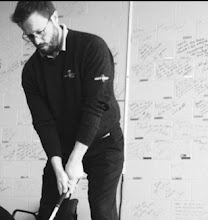Wednesday, 24 February 2010
Tips for Winter Training
FROM THE TEE
Alignment
Never assume the mat is pointing in the right direction. Use a pre-shot routine that makes sure you are lined up correctly.
Solid base
Especially in windy conditions and off the mats. Widen your stance and keep the lower half of your body quiet.
Keep it straight
You’ll get less run in the winter. Try a fairway wood to improve consistency and you won’t lose all that much distance.
IRON PLAY
Grade your lie
Stand with your back to the flag and “grade” your lie. Think traffic lights – attack (green), lay up (yellow) or knock out sideways (red).
Mud ball
Take more club than usual and swing easy to reduce spin and help keep it online.
SHORT GAME
Get it rolling
Use a rescue club or fairway wood on temporary greens and putt how you would normally.
Keep it low
The chip and run reduces the chances of mis-hits and unpredictable bounces – compared to the high, lob shot.
Wet sand
The lob wedge can be very useful. Make a smooth, shallow swing. You don’t need to open the face or your stance.
Alignment
Never assume the mat is pointing in the right direction. Use a pre-shot routine that makes sure you are lined up correctly.
Solid base
Especially in windy conditions and off the mats. Widen your stance and keep the lower half of your body quiet.
Keep it straight
You’ll get less run in the winter. Try a fairway wood to improve consistency and you won’t lose all that much distance.
IRON PLAY
Grade your lie
Stand with your back to the flag and “grade” your lie. Think traffic lights – attack (green), lay up (yellow) or knock out sideways (red).
Mud ball
Take more club than usual and swing easy to reduce spin and help keep it online.
SHORT GAME
Get it rolling
Use a rescue club or fairway wood on temporary greens and putt how you would normally.
Keep it low
The chip and run reduces the chances of mis-hits and unpredictable bounces – compared to the high, lob shot.
Wet sand
The lob wedge can be very useful. Make a smooth, shallow swing. You don’t need to open the face or your stance.
Friday, 5 February 2010
Putting tip for Rhythm
To begin finding your putting rhythm, comfortably walk for one minute (60 seconds) taking normal steps, timing yourself with a stopwatch and counting your steps. Do not rush or dawdle, just walk at your normal pace. Do it a few times and take an average of the number of steps you normally take per minute. Now take that number of steps per minute, subtract 70, and then double the number. (Ex: Walking at 110 steps per minute = (110-70) x 2 = 80). This “initial base rhythm" is measured in beats per minute and will correlate to the rhythm of your putting stroke back and through, like the tempo of a metronome. It may not be your final putting rhythm, but it is a starting point for finding it. Get a metronome, set it at 80 beats per minute, and feel your putting stroke as you putt to that rhythm. Close your eyes and adjust your stroke rhythm (change the metronome setting up or down) from there until the putting stroke feels almost effortless. As you work with a metronome and rhythm drills, remember to stroke all of your putts, from two-footers to 100-footers, at the same rhythm. If you can execute this rhythm in a pendulum motion, you will eliminate most of the sources of variability in putting.
Subscribe to:
Comments (Atom)


















